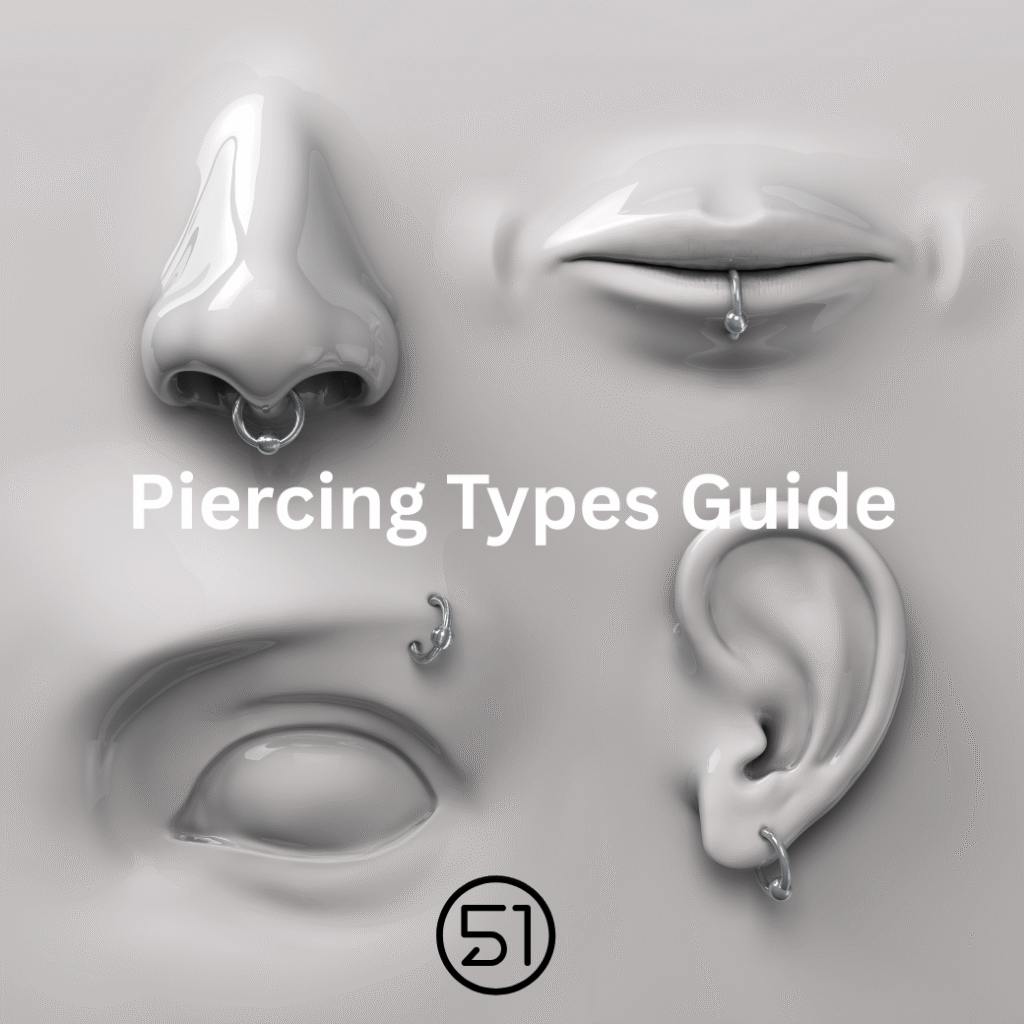
The Ultimate Guide to Ear Piercing Types (From Lobes to Legends)
So, you’re thinking about getting your ear pierced. Brilliant. Whether it’s your first-ever lobe piercing, or your tenth cartilage piercing, you’ve landed in the right place. This is the ultimate guide to ear piercing types — no fluff, no fakery, just honest insight, expert advice, and a little bit of Area51 cheek.
We’ll walk you through every type of ear piercing, from the classics to the “where even is that?” options. Along the way, we’ll cover placement, pain levels, healing time, and aftercare basics. Whether you’re planning a single stud or a full ear constellation, consider this your go-to roadmap.
Why This Guide Matters (And Why You Should Read It First)
Choosing the right ear piercing isn’t just about what looks good. It’s about anatomy, lifestyle, healing, and making sure you don’t end up Googling “why does my ear feel like it’s plotting revenge?” three weeks later.
This guide is for:
-
- First-timers who don’t know their helix from their daith.
- Piercing veterans planning their next stack.
- Parents researching piercing options for their teen.
- Anyone who wants to get pierced correctly (and with style).
At Area 51, we’ve been piercing since 1998. We’ve seen trends come and go (RIP eyebrow rings), and we know how to help you get pierced safely, stylishly, and confidently.Ready? Let’s get stuck in.
Ear Piercing Anatomy: Know the Land Before You Claim It
Let’s start with the basics. Here’s a quick tour of the ear’s regions:
- Lobe – The soft, fleshy bit at the bottom (prime real estate).
- Helix – The outer rim of cartilage at the top/side.
- Forward Helix – The front part of the helix, closest to your face.
- Tragus – The small flap of cartilage in front of the ear canal.
- Anti-Tragus – Opposite the tragus, just above the lobe.
- Conch – The middle cartilage (inner bowl).
- Daith – The fold of cartilage above the ear canal.
- Rook – The ridge between the inner and outer ear.
- Industrial – A barbell piercing connecting two points at the top of the ear.
Each Ear Piercing Explained
Understanding your ear’s anatomy is key to making informed decisions about which piercings will suit you — both visually and functionally.Now let’s get into the juicy stuff.
Low and Mild Ear Piercing Pain
Lobe Piercing
Placement: Classic lower ear. The gateway drug of the piercing world.Pain Level: Low. Usually described as a pinch.Healing Time: 6–8 weeks.Why it’s great: Fastest to heal, easiest to maintain, most versatile. At Area51: We use sterile, hollow needles — never guns. And we’ll help you choose titanium jewellery.
Upper Lobe Piercing
Placement: Just above your original lobe piercing — popular for doubles or triples.Pain Level: Low. Still in the soft tissue zone.Healing Time: 6–8 weeks.Style Tip: Perfect for stacking with small hoops or studs.
Helix Piercing
Forward Helix Piercing
Placement: Front rim of the upper ear, near your temple.Pain Level: Moderate. Quick, sharp — over in a blink.Healing Time: 3–6 months.Stack Tip: Looks stunning in singles, doubles, or triples for a neat, modern aesthetic.
Tragus Piercing
Placement: That firm little flap at the front of your ear canal.Pain Level: Moderate. You’ll feel pressure more than pain.Healing Time: 3–6 months.FYI: Wearing earphones might be tricky for a while. But the payoff? Pure edge.
Anti-Tragus Piercing
Placement: Above the lobe, opposite the tragus.Pain Level: Moderate. Small area, big impact.Healing Time: 4–9 months.Style Tip: Pairs beautifully with a tragus for that balanced but bold look.
Conch Piercing
Placement: The central cartilage area inside your ear.Pain Level: Moderate to high. It’s deep cartilage — expect a punch, but it’s quick.Healing Time: 6–12 months.Jewellery Ideas: Start with a stud. Switch to a captive bead ring once healed for that iconic inner-ear ring look.
High Ear Piercing Pain
Daith Piercing
Placement: Inner fold of cartilage above the ear canal.Pain Level: High-ish. Awkward angle, but over quickly. Surprisingly tolerable for most.Healing Time: 6–9 months.Fun Fact: Some say it helps with migraines (unproven but stylish).
Rook Piercing
Placement: Inner ridge above the daith.Pain Level: High. Small, tough cartilage — expect pressure.Healing Time: 6–9 months.Pro Tip: Keep the area dry and clean.
Industrial Piercing
Placement: A straight barbell connecting two piercings at the top of the ear.Pain Level: High. Two piercings, double the drama.Healing Time: 6–12 months.Commitment Level: High. But if you’re after bold and badass, this one’s a statement.
Bonus: Ear Stacks, Combinations & Curation
Ear piercing isn’t just a point-by-point exercise — it’s a vibe. Want a stacked look that feels intentional? Book a consultation and we’ll help you plan a roadmap.
Popular combinations:
- Lobe + Upper Lobe + Helix.
- Tragus + Conch.
- Double Forward Helix + Flat.
- Industrial + Lobe chain.
Add a mix of studs, rings, and flat backs to complete the look.
FAQs About Ear Piercing Types
What’s the least painful ear piercing? Lobe, hands down. It’s soft tissue and heals fast.
What’s the hardest ear piercing to heal? Cartilage combos like industrials or rook piercings take the longest and require consistent care.
Can I get more than one piercing in one session? Yes — we often do two or three if your body can handle it. Just follow aftercare religiously.
Do you pierce with guns? Nope. Never. Hollow needles only — for your comfort and safety.
Can I choose my jewellery? Absolutely! We use only implant-grade titanium, and help you pick a style that suits your anatomy and your taste.
Final Thoughts: Your Ear, Your Style
There’s a piercing (or five) out there for everyone. Whether you’re going minimalist or maximalist, classic or edgy, we’ll help you do it cleanly, safely, and with a side of banter.
At Area 51, we don’t just pierce ears. We curate stories, personalities, and aesthetics — one sterilised needle at a time.
